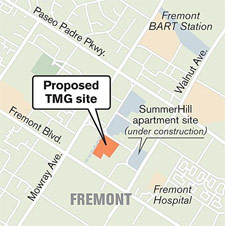News & Awards.
including honors for “Best Mixed Use,”
“Best Office,” and “Best Historic Rehabilitation”.

TMG Partners will kick off efforts to transform downtown Fremont into an energetic, pedestrian-friendly urban district with the groundbreaking next year on a 467-unit apartment project.
The developer has been working with the city since 2008 on a master plan to redevelop downtown's 110 acres. The City Council adopted the master plan in October, opening the door for TMG to develop the first project.
"(TMG's project) will really set the tone for the type of project that we're hoping to see in the downtown," said Jessica von Borck, Fremont's downtown project manager.
TMG's preliminary design consists of two buildings on a 6.7-acre parcel at the corner of Capital Avenue and State Street. The developer is working with Steinberg Architects to design the project with ground-floor commercial space along Capital Avenue. The site was zoned for residential or commercial.
"The housing market is very hot, especially apartments," said David Cropper, a partner with TMG.
TMG will spend the rest of this year negotiating to buy the site from the city along with finalizing entitlements for the project.
The process is on the fast track to get ready for construction by May 2014, von Borck said.
Two blocks away, SummerHill Apartment Communities is building Paragon, a 301-unit community at Walnut Avenue and California Street. That project is also within the downtown plan area, but kicked off before the plan was implemented.
"We felt that the market, even during the downturn, was underserved," said Robert Freed, CEO of SummerHill. "There hadn't been a new Class A apartment building in the area in over 10 years. The market was ready to have a high-quality, high-amenity product."
SummerHill expects the first residents in July. Rents will start at $1,865 for a one-bedroom and $2,400 for two bedrooms. The developer owned the site for several years before starting construction and planned to build a condo project before the recession hit.
"The (downtown) plan confirms what SummerHill is doing," Cropper said. "It's good for the city and it's good for encouraging other investments to know you're not the only guy in the neighborhood."
Both TMG and SummerHill's projects will not only bring more residents, but also bring to the market higher-quality units. TMG's project will likely consist of five stories.
"It's what most properties are heading towards in the Bay Area when you're near transit. You have to build that kind of density to justify land costs," Cropper said.
The downtown plan offers options for higher densities, greater height limits and a streamlined approval process. The plan also includes extending Capital Avenue to connect to Fremont Boulevard and revamping the area with streetscaping, landscaping and wider sidewalks.
Fremont, with close to 220,000 residents, is the Bay Area's fourth-largest city. Because it was formed out of five separate communities - Centerville, Niles, Irvington, Mission San Jose and Warm Springs - in 1956, it lacks a core downtown.
"We are creating a unique urban environment," von Borck said. "This is our strategy to emerge from an auto-centric suburbia."


